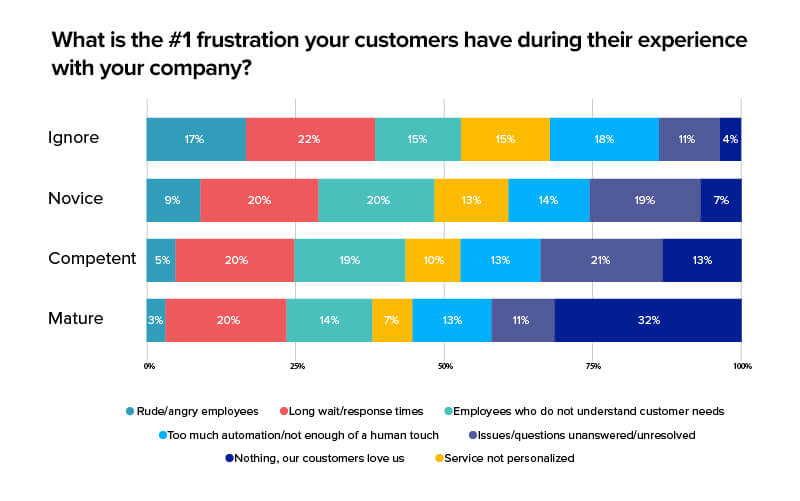Experience Design – The concept that focuses on not simply your mobile application but the experience that you are able to offer at the back of it.
The term coined a few decades back has now found itself as a prominent part of the design thinking process that leading app development companies follow – at least, a major part of the design process that Appinventiv follows.
The term then eventually branched out to two more concepts that now are being applied by a number of businesses across the globe, with the hopes to become successful.
In this article, we are going to compare just those two elements – User Experience (UX) vs. Customer Experience (CX) and help you gather an understanding of how to find the commonalities and improve your business’s experience.
But in order to get an understanding of the difference and commonalities of the concepts, we will first have to see how designing as an industry has evolved.
Evolution of Design
In 1998, Jim Gilmore and Joe Pine through one of their HBR article introduced the world with a new design thinking process which was based on Experience. While the economy at that time was still pretty much focused on industrialization, it was only in the third decade of the 21st century when a shift was first seen towards experience based design.
The coming of the internet changed how the design world now operated, even though the industry was now 250 years old. It started with UX era where the focus of industrial design had now shifted to digital product design.
And then eventually, users started asking for more. They started seeking not just great product but also great service experience – something that laid the basis of customer experience design.
After every twist and turn that design world took, the present state of it has placed the domain at the forefront of experience centric designs.
A study by ThinkJar research has identified that over 55% of customers are readily willing to pay more in return for a good experience. Now when we talk about experiences in design, there are two concepts that come out as the ones which can be trusted to best define the domain of the combined elements – Mobile User Experience and Customer Experience design.
Let us first get to the very basic definition of both the concepts – get you the answer to What is UX vs CX – before we move on to the scope of customer experience becoming the base design trend of companies across industries.
What is User Experience?
UX is what the customers experience within any specific product – app, website, or any other software. Elements of interface design around information architecture, usability, comprehension, navigation, visual hierarchy, etc are some of the UX design principles that come together to make the experience either bad or good, as any mobile UX designer would tell you.
What is Customer Experience?
Mobile Apps CX is a lot more than Mobile apps UX design. It is the experience that users get across all of the brand’s channels of which your app or website only a part. Elements that users interact at this stage falls under the radar of advertising, sales process, pricing fairness, product delivery, etc. It involves all the interaction that occurs as a user identifies, evaluates, purchases, uses, re-engages and leave the software.
Let us deep-dive into the definitions further to explain what stands as a differentiating factor between the two often considered synonym terms.
Let us help you get the answer to What is the difference between user experience and customer experience?
User Experience (UX) vs. Customer Experience Design: What Separates Them?

The definition of customer experience and user experience design themselves hint at what separates them – the former being a wholesome approach of experience that a user/customer draws both on a specific medium and off, the latter is more concentrated on platform-specific experience – ensuring that your software or mobile app is leaving a lasting impression.
But if you see it more from a word on word level, the difference ends up becoming all the clearer. While on one end we are talking about the experience of a user, on the other hand, there is this study of customer’s experience – The focus being on the words Customers and Users.
Customers are generally those people who have been users of your mobile app and only after experiencing your offering, they decided to become your customers – a key difference that draws the Venn diagram that we saw above.
This switch from CX to UX and vice versa is where the difference in User Experience (UX) vs. Customer Experience (CX) lie. Let me give you an example to clarify it further.
Scenario 1: Bad UX, Good CX
Imagine you have an on-demand ridesharing app.
The functionalities inside it are so confusing that the user ended up booking and getting charged for a vehicle type which was not even their first choice. They take this complaint to your customer care and get a discount.
The experience that they got inside the app is bad UX and the experience they drew from your customer care is what good CX entails.
Scenario 2: Good UX, Bad CX
Taking the same ride-sharing app example for the second scenario as well, imagine your users having a very good time inside the app – everything works perfectly, as intended but one fine day, the drivers keep canceling the ride and on the third cancellation, your users were charged X amount. Now when they contacted your staff for a refund, they were not entertained – an event which turned them off.
The experience that your app gave them was the example of good UX but the experience that your staff gave them by not solving the issue is bad CX.
Hope this helped clarify the difference between UX and CX for you. But in order to make it a matter of quick look, let us help you with the differences in the form of a table:
[table id=16 /]
If there is anything that the definition and differences that you just read shows, it is the fact that Customer Experience – unlike what is supposed to be the job of your contact center team – should be made a lot more mainstream.
What I mean by mainstream is that Customer Experience program should be incorporated deep into your design module – one that is not just limited to your mobile app design.
This is something that would require you to club your UX process with CX, for only then you will truly be able to take advantage of the concept of wholesome experience design and give your users a pleasant brand experience both on and off digital medium.
Before we move on to giving you the ways to incorporate your User Experience design process with Customer Experience modules, let us give a tad focus to the latter and see the importance of preparing for its rightful implementation.
Why Do You Need to Focus on Customer Experience?
Acing your customer experience is the secret sauce that would help you succeed in the market. Your way out to ensure that your users are not just engaged with your application but the complete mobile business as a whole.
It is what you can use to ensure that your users not just enjoy your software offering but also your whole business.

The frustrations list that you see in the graph above is one whose answer directly lies in having a strategically devised customer experience plan in your mobile app business.
It all walks as a cycle – The stronger your preparations to help solve all the customers’ pain points the lesser would be the complaints and greater would be the scope you attaining brand resonance eventually.
This focus on customer experience has led to the creation of a market in which businesses are very optimistic about. Here’s an infographic – made by combining the finding of Hotjar’s survey results on customer experience trends – that highlights what the unanimous feeling about the concept is.

Now that we have looked at what the concept of User Experience and Customer Experience entails, it is time to get down to some action items – How to Improve Customer Experience using your User Experience modules?
A. Do a Thorough Pre-Launch Testing
The first step to ensuring that your business is well accepted by your users and prospective customers is to perform thorough pre-launch testing – a step that follows every successful pre-planned app development process. You will have to make sure that your offering is ready to first attract and then keep your users engaged.
B. Make Feedback Collection Process Easy
Make it easy for your users to leave feedback on your application by keeping all the communication lines open and visible to them. Put your contact information on the screen and section which is most easily visible.
C. Create an Omni-Channel Experience
Understand that your users and customers are available on multiple platforms and sources. And then take that understanding and transform it into an omnichannel experience for your users, ensuring that the result that they get are similar across all platforms in order to improve customer experience that you are presently offering.
D. Involve Multiple Teams
While it is a given that your customer support team will not have an understanding of design, it is nevertheless very important that you involve them to get a complete understanding of where your users stand and what they expect out of the service you are offering them.
So, here was everything that you need to understand about what differentiates customer experience with user experience and how you can take that understanding further into advancing your customer experience efforts and find your own answer to how UX improve CX.
And now that you have the info., it is time to apply the information in your application. Let our Customer Experience Consultants help you.

strategies your digital product.




